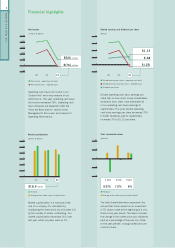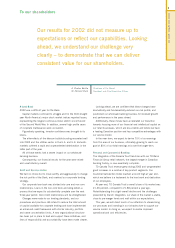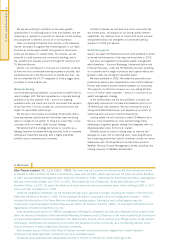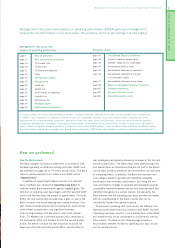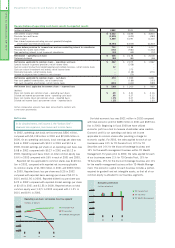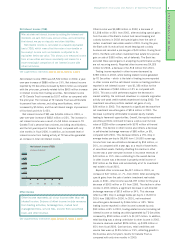TD Bank 2002 Annual Report Download - page 13
Download and view the complete annual report
Please find page 13 of the 2002 TD Bank annual report below. You can navigate through the pages in the report by either clicking on the pages listed below, or by using the keyword search tool below to find specific information within the annual report.
11
HOW WE PERFORMED IN 2002
Taxes
The Bank carries on many businesses in many different locations
with differing outcomes, resulting in a mix of tax payments and
tax recoveries. The Bank continues to pay significant amounts of
tax to governments across Canada. Supplementary table 8 on
page 38 lists the various taxes we’ve paid over the past five years.
Note 12 of the Bank’s consolidated financial statements
sets out the key tax measurements under generally accepted
accounting principles. It should be noted that for the year just
ended, taxes of approximately $4.5 million are required to
change the effective income tax rate by one percentage point as
compared with $13 million last year and $14 million in 2000.
While the rate of reduction of Canadian corporate taxes has
slowed, it still holds promise for lower future taxes. However, as
governments tend to tax income before it is recognized for
accounting purposes, the decline in rates tends to increase tax
expense as this prepayment of taxes will be recovered at lower
tax rates.
In the ordinary course, future tax assets tend to increase in
banks. This trend was accelerated by the substantial sectoral
loan provisions recorded in 2002. Together with the amortization
of purchase-related intangibles (which decreased our future
tax liability), this increase led to the creation of a net future tax
asset. The effective use of this asset is dependent upon a return
to ordinary levels of profitability, particularly in the Bank’s
U.S. operations.
Balance sheet
See Consolidated balance sheet page 44
Total assets were $278 billion at the end of the year, $10 billion
or 3% lower than as at October 31, 2001. Lower volumes from
trading securities contributed $13 billion to the decrease in total
assets with securities purchased under resale agreements repre-
senting $7 billion of the decrease. Personal loans, including
securitizations, increased by $3 billion, primarily attributable
to a solid performance in real estate secured lines of credit at
TD Canada Trust. At the end of the year, residential mortgages,
including securitizations, increased by $2 billion from last year
end to $69 billion.
As at October 31, 2002, wholesale deposits decreased by
$11 billion and securities under repurchase agreements
decreased by $6 billion as compared with October 31, 2001.
Personal non-term deposits grew by $4 billion from October 31,
2001 to reach $51 billion at the end of fiscal 2002, with
TD Canada Trust accounting for the majority of this increase.
Personal term deposits remained unchanged at $50 billion
compared with the prior year.
The Bank also enters into structured transactions on behalf
of clients which result in assets recorded on the Bank’s
consolidated balance sheet for which market risk has been
transferred to third parties via total return swaps. As at
October 31, 2002, assets under such arrangements amounted
to $12 billion (2001 – $11 billion). The Bank also acquires
market risk on certain assets via total return swaps, without
acquiring the cash instruments directly. Assets under such
arrangements amounted to $3 billion as at October 31, 2002
(2001 – $6 billion). Market risk for all such positions is tracked
and monitored, and regulatory market risk capital is required.
See Note 15 of the Bank’s consolidated financial statements for
more details of derivative contracts.
Off-balance sheet arrangements
Special purpose entities
Loan securitizations are an important part of the financial
markets, providing market liquidity by facilitating investor access
to specific portfolios of assets and risks. In a typical loan
securitization structure, the Bank sells assets to a special
purpose entity (SPE) and the SPE funds the purchase of those
assets by issuing securities to investors. SPEs are typically set up
for a single, discrete purpose, are not operating entities and
usually have no employees. The legal documents that govern the
transaction describe how the cash earned on the assets held in
the SPE must be allocated to the investors and other parties that
have rights to these cash flows.
In the normal course of operations, the Bank securitizes
residential mortgages, personal loans and credit card loans to
diversify its sources of funding and to optimize the management
of its balance sheet. Bank-originated securitized assets not
included on the consolidated balance sheet amounted to
$15 billion compared with $18 billion a year ago. Further
details are provided in Note 4 of the Bank’s consolidated
financial statements.
In addition, the Bank sells trading securities to SPEs in
conjunction with its balance sheet management strategies. The
Bank does not retain effective control over the assets sold. Assets
sold under such arrangements at October 31, 2002 amounted to
$5 billion (2001 –$2 billion). The Bank enters into total return
swaps with the sale counterparties in respect of the assets sold.
Market risk for all such transactions is tracked and monitored,
and market risk capital is required.
The Bank also assists its clients in securitizing their financial
assets. The Bank may provide administrative, credit
enhancement or liquidity facilities to the resulting SPEs. The
Bank does not provide employees to the SPEs, nor does it have
ownership interests in these SPEs and all fees earned in respect
of these activities are on a market basis.
Lending-related commitments and contractual obligations
Details of off-balance sheet lending-related commitments by
remaining maturity and contractual obligations relating to
subordinated notes and debentures, and operating lease
commitments are disclosed in supplementary table 17 on
page 42 of this annual report.
Critical accounting policies
The Bank’s accounting policies are essential to understanding its
results of operations and financial condition. A summary of the
Bank’s significant accounting policies is presented in Note 1
of the Bank’s consolidated financial statements beginning on
page 48 of this annual report. Some of the Bank’s policies
require subjective, complex judgements and estimates as they
relate to matters that are inherently uncertain. Changes in these
judgements or estimates could have a significant impact on the
Bank’s financial statements. The Bank has established effective
control procedures to ensure that accounting policies are applied
consistently and that the processes for changing methodologies
are well controlled and occur in an appropriate and systematic
Management’s Discussion and Analysis of Operating Performance



